Healthcare Email Marketing: Importance, Examples, Strategies, and Tools
Healthcare professionals work hard to win their patients’ trust. While your ultimate goal is to keep people healthy, you still want to maintain patient relationships for when they need you.
Healthcare email marketing can help make sure that you are their first pick when something does happen. Starting a dialogue with emails enables you to keep in touch with your patients, build long-lasting relationships, and stay top-of-mind.
If you are a marketer in a hospital, doctor’s office, healthcare, or wellness center, you should adopt healthcare email marketing strategies to better engage your patients and grow your practice.
Don’t know how to optimize your existing strategies or even where to start? You are at the right place!
This guide to healthcare email marketing will give you examples, strategies, and tools to get the most out of email marketing.
Let’s explore!
Why should healthcare businesses do email marketing?
Email is a unique marketing channel. You can completely control your message with a target audience that wants to hear from you. It is a mutual relationship that empowers you to establish a stronger connection.
Hopefully, you only see your patients a few times per year. When seeing them, you build a rapport that can make them feel comfortable. Email enables you to extend that trust throughout the year.
Email marketing is proven to be valuable and cost-effective. Studies show that the average open rate for healthcare emails is 23.46%, with a super-high 3.62% CTR (click-through rate). It is one of the highest open rates among all industries.
In short, healthcare businesses need email marketing to:
- Maintain communication
- Deliver essential information
- Automate appointment reminders
- Engage patients
The main point is, it can keep the link between you and your patients even when they do not need your medical assistance at that time.
10 best healthcare email marketing examples
The people on your mailing list really want to hear from you, so what are you gonna say?
Keep in mind that your goal is to extend your relationships with your patients, not pressure them to come in for an appointment.
To inspire you, we have put together 10 healthcare newsletter ideas and examples. Let’s explore!
1. Start with an automated welcome email
A welcome email is the first contact with your subscriber.
When someone registers, you set up an automatic message that will be sent at the exact moment they confirm. That immediate response can set the tone for the relationship. It lets people know that they’re important and that you’re ready to meet their needs.
Thus, the welcome email is your opportunity to set expectations and create a strong first impression.
For example, Gillian Pediatrics does an excellent job of welcoming new subscribers.

2. Send appointment confirmation emails
If you don’t confirm your patients’ appointments, chances are they won’t show up.
| If you are running email marketing for dentists, below is an example of an appointment confirmation email from **The Practice | Beverly Hills**. |
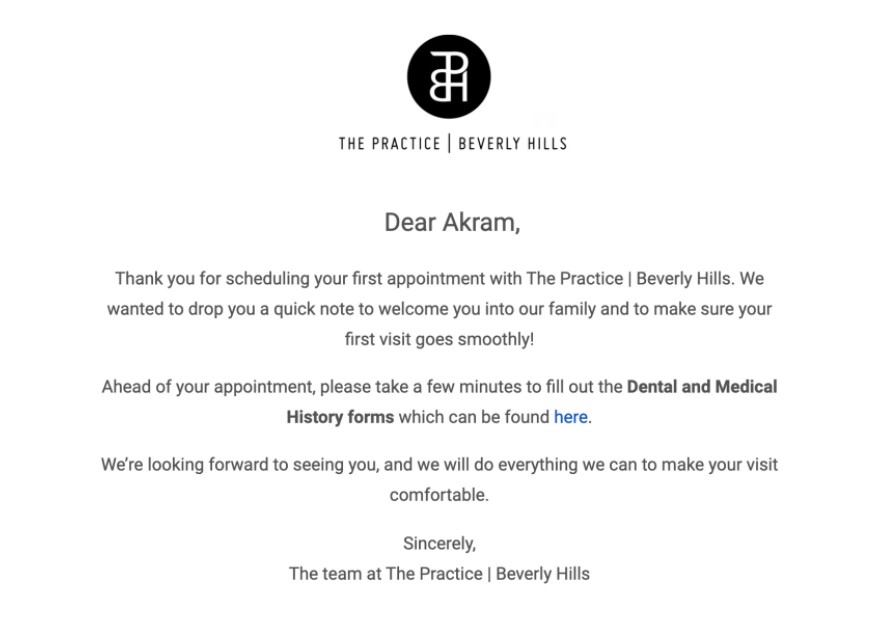
You could do differently in this appointment confirmation email to add an “Add to Calendar” CTA (call-to-action) button right in the middle of the email.
3. Confirm your clients’ orders
A good order confirmation email can captivate the client’s enthusiasm and eliminate confusion. Most importantly, it can lay the groundwork for a successful relationship with your customers.
Below is an order confirmation email from Fullscript.
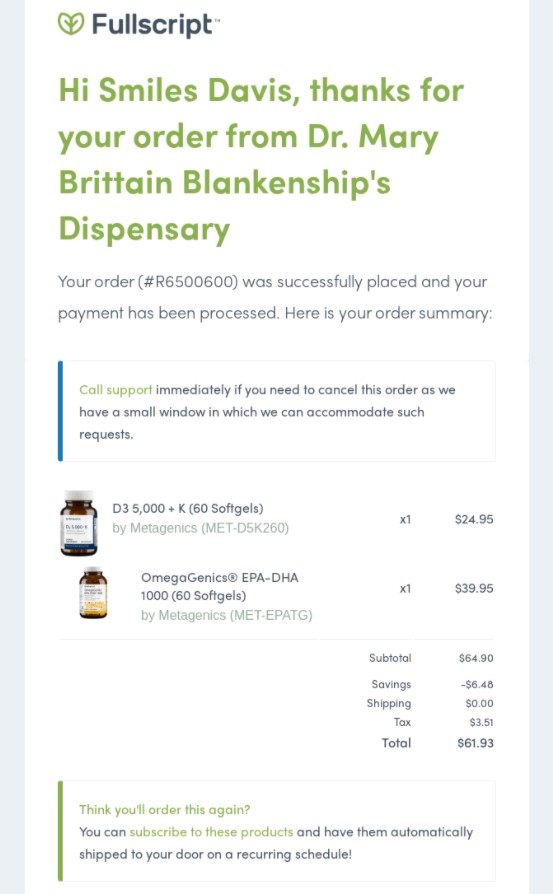
4. Send a happy birthday email
Sending a happy birthday email is a good way to personalize your healthcare newsletter. It shows how considerate you are and helps you keep your customer relationship vibrant and ongoing.
Below is a nice happy birthday email that can inspire you:
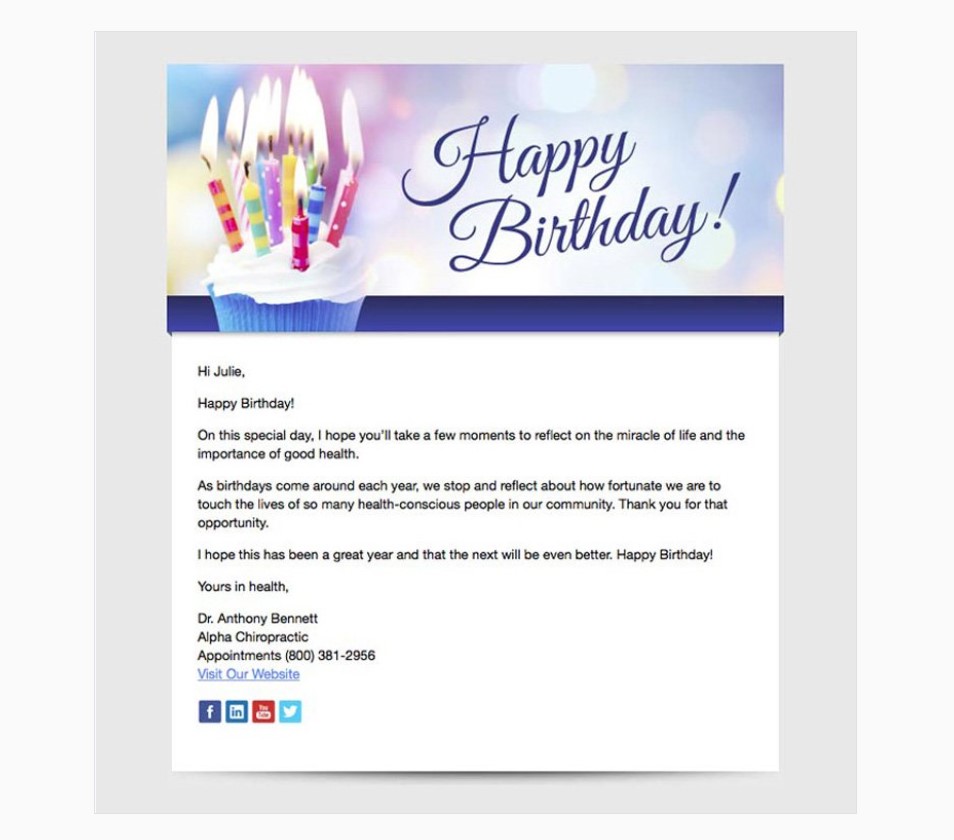
5. Send helpful health tips and news
A common and effective email marketing practice across all industries is to generate content that shows people you’re really an expert in your field that wants to help others.
The healthcare sector is no different. Set some time aside for your content marketing: write helpful articles or develop a set of health tips that can help your patients. Then, promote your knowledge via your newsletters.
Fullscript takes advantage of this to promote content to their contacts.

6. Send local events
Subscribers actually want to know that you care about their health beyond when they need you. Show them that you really care and encourage them to be proactive with their health by sharing different health-related events and seminars that they can attend.
Or, you can even create and promote your own events. For instance, Pediatric Associates of Frisco created the Summer Safety Event and sent this colorful and fun newsletter to promote it.

7. Update your patients
It is recommended to share major updates with your patients and customers, especially if this update concerns them directly.
Here is a heart-warming healthcare email shared with customers during Hurricane Florence. They told their customers that the circumstances would affect their orders, and they are here to help those affected by the hurricane.
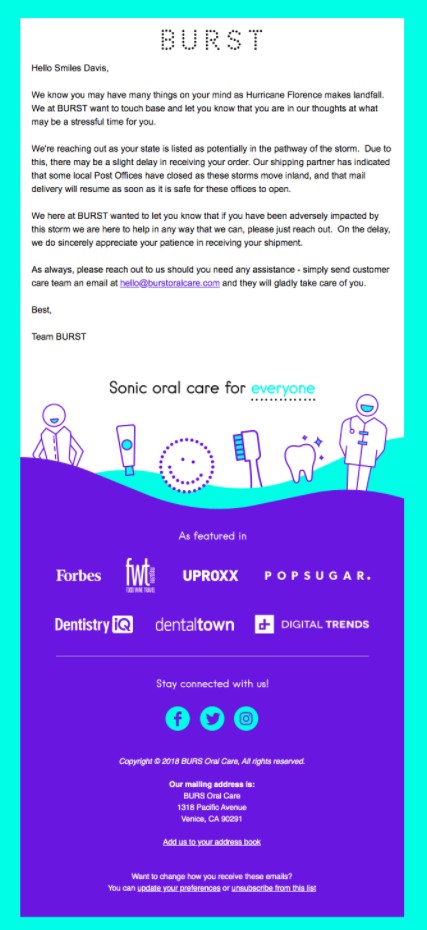
8. Use patient stories and testimonials
When it comes to health-related concerns, there can be a lot of different emotions at play that can affect people’s decision-making.
An effective way to address these types of sensitive matters is to use real patient stories. Hearing about similar health experiences will let others know that they’re not alone.
Tennessee Reproductive Medicine created the following newsletter, which features a couple’s journey through IVF, along with educational content and a patient testimonial. For a best-case scenario, this would be segmented to target prospective patients dealing with the same issues.
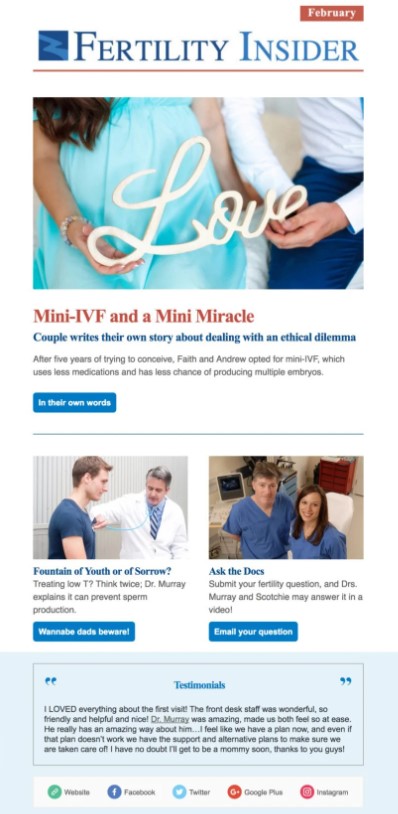
9. Offer special promotions
After sending several marketing emails that establish the value you provide, it’s perfect for sending them a promotional message to grow your sales.
The following example from Lady Lakes Dentist does an amazing job by offering a discount for a teeth whitening service, while including some other content resources for subscribers who aren’t interested in that service.
The email uses a nice image to draw the reader in and includes a clear CTA.

10. Ask for a referral
When you feel like you have reached a certain level of positive experiences and trust with a patient, it is normal to ask for a review or even a referral.
Typically, reviews from real people are priceless, especially in the healthcare sector. When you ask people to refer you, you have successfully flipped your marketing funnel where your retention efforts transform into new patient acquisitions.
This email from NY & NJ Family Dental is delivered right after an appointment when the experience is top-of-mind. They make it really easy to find the CTA button to leave a review.
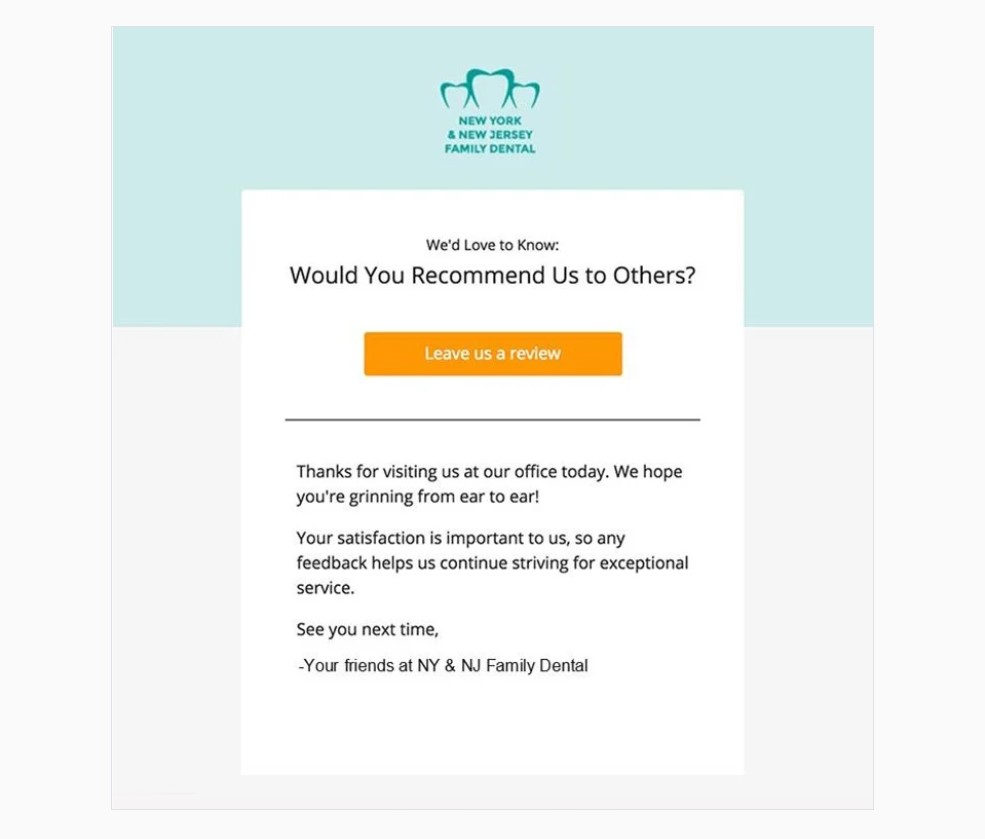
10 actionable healthcare email marketing strategies
1. Include opt-in forms
If you have your own blog or use digital advertising to attract new visitors to your website, you can generate embedded forms, pop-ups, or custom landing pages using your email marketing software.
You should place them strategically in various places that won’t interrupt the website experience. The best places to place a signup form include:
- Blog sidebar
- Blog footer
- Underneath each blog article
- “About” page
- Pop-up on your blog
Below is an example of a nice footer subscriber form from Michigan Dental Association. It is well-designed with a clear value proposition of what the subscriber will receive.
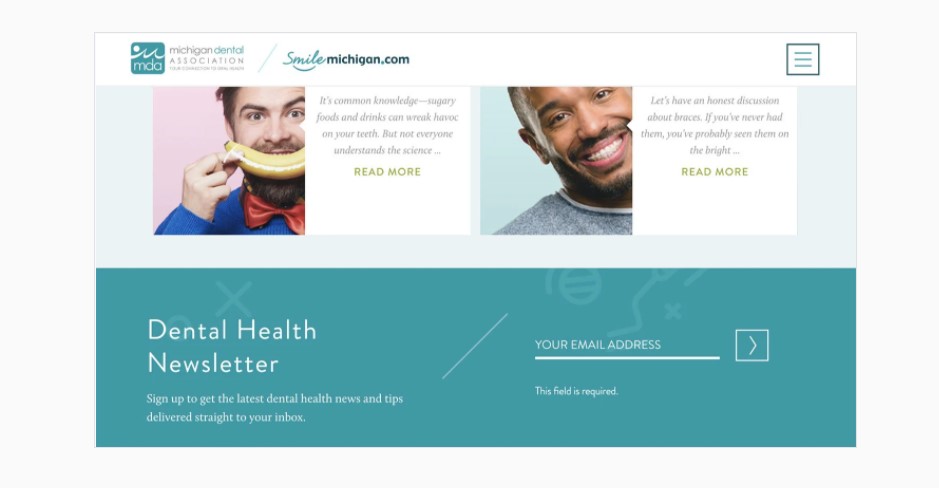
2. Leverage social media for email signups
Your followers on social media networks like Facebook, Instagram, or Twitter are either current patients or prospects that want to hear from you. Why not get them on your mailing list as well?
You can add a link to your signup landing page on social media channels. When people opt-in to your email list, you’ll have a more direct and effective way of communicating with them.
3. Segment your patients
Your patients are there for various purposes, and that’s enough reason not to treat them all the same when running your email marketing campaigns.
You can use different contact tags and fields to label your patients based on:
- Their health condition
- If they are first-time patients or returning
- Age, gender, and other demographic data
Segmentation enables you to send relevant content to patients that match their interests and offers the value they actually need.
4. Write an engaging email subject line
It comes as no surprise that your email open rates depend significantly on your subject line.
There is actually no magic formula to writing the perfect healthcare email subject line. However, you can take advantage of some useful tips to demand respect and attention (and not get tagged as spam).
- Get it right in (about) 50 characters
- Tell, don’t sell in the subject space
- Be relevant and important with a dash of urgent
- Personalize, customize, or tailor
- Understand and avoid spam trigger words
Read more guidelines on writing email subject lines:
- How to Write Best Subject Lines for Open Rates?
- 33 Holiday Email Subject Lines and Most Favored Emojis
5. Personalize your email copy
Even if you’re sending messages to hundreds or even thousands of people, it’s vital to give the impression that you’re talking directly to one person.
Email marketing for healthcare can be personalized. But how to do that?
- Use your recipients’ first names
- Use their date of birth
- Trigger their interests
- Include your real name and picture
- Send customized emails based on the opt-in source
You need to experiment and then analyze to understand what works best.
Read more: Best Email Personalization Tips
6. Automate your email campaign
Once you start expanding your healthcare email list, it becomes difficult to manually send emails to each subscriber at the right time.
Email automation can solve this problem by allowing you to send emails based on behavioral, temporal, and other triggers. For instance, when someone subscribes, you can automatically send a welcome email, or set triggers to send your patient a reminder of an annual appointment. One of the tools that can be used for healthcare is a FHIR server, which allows for the secure exchange of healthcare data between different systems.
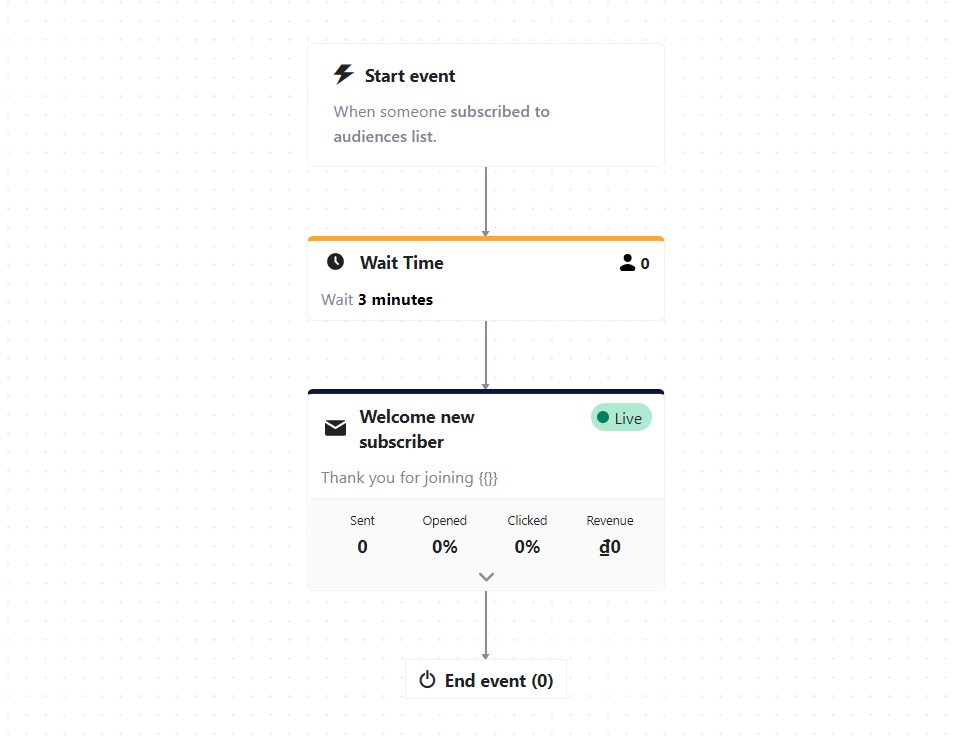
Related topics:
- Top 7 Best Email Marketing Automation Tools
- 10 Proven Email Automation Workflows
- How to Create a Complete Email Automation Workflow
7. Set a schedule for your emails
When setting a schedule for your healthcare email marketing campaigns, you become reliable to prospects because they will always know when they’ll be receiving new information from you.
It is also essential to set a schedule so that you don’t send too many emails each month. Determine a consistent time to send each of your emails - which should typically be twice per week or monthly.
When your emails are consistent, you can make sure that you are in your patients’ inboxes regularly - but not enough to annoy them.
8. Say no to spam
On average, 24.16% of emails are delivered to spam folders monthly. Your healthcare emails can land in spam folders, even if your patients signed up to receive them.
Several tips to bypass the spam filter include:
- Avoiding spam words and phrases, such as “100% Free,” “Save,” “Best price”
- Building your own email list instead of buying from an outside party
- Properly authenticating your emails, so email service providers know you are legitimate
- Cleaning up your email list regularly because ignored emails can lower your engagement significantly
- Including a double opt-in
- Creating a preference center, where your patients can decide which type of content they want to receive and how often
Learn more:
9. Optimize for mobile
Are your healthcare emails optimized for mobile users?
If not, this must be something to start with today!
To optimize your healthcare emails for mobile, consider the following tips:
- Don’t use heavy images
- Use responsive email templates
- Be simple and straightforward in your email copy
- Break up your sentences and paragraphs
- Use CTA buttons instead of text links
10. A/B test your messages
If you desire the best results from your healthcare email marketing campaign, you should A/B test your email content.
You could start by A/B testing your email subject line to see what promotes the highest open rate. For instance, you could test whether or not your subject line in the form of a question has a higher open rate than the one that is a statement.
Furthermore, you could A/B test numerous email elements, such as different headings, number of images, or inclusion of links. Then, you can make sure that all of your healthcare emails have the best open rate possible.
3 best healthcare email marketing tools
1. AVADA Email Marketing
AVADA Email Marketing is number one for a simple reason: it makes email marketing for healthcare practices easy to set up and maintain!
With AVADA Email Marketing, you can take advantage of:
-
Automation workflows. With premade automation email series, you can follow up with your audiences at any touchpoint. The platform supports welcome email series, win-back emails, order follow-up emails, and so on.
-
Email campaigns. You can send mass emails to update your patients and deliver appealing promotions. Plus, stunning templates are also available!
-
Segmentation. AVADA Email Marketing helps you send the right messages to the right people with advanced segmentation.
-
Forms. You can grow your email list easily with a number of amazing forms, such as newsletter popup, spin to win, inline form, etc.
-
Customer service. The AVADA team is always friendly, knowledgeable, and professional to help solve your problems. Hence, you don’t need to worry about your healthcare email marketing!
Its blog posts offer more details on tailoring your emails to the right audience and giving many practical examples to get you started. Noticeably, the platform offers a free plan with lots of excellent features. You should test it out today!
TRY AVADA EMAIL MARKETING FOR FREE
2. GetResponse
This email marketing tool is great if you’re ready to really interact with clients via specialized tools. GetResponse helps you design a landing page specific to your practice. Looking to expand to video? The tool can also organize and distribute webinars via email.
This platform isn’t free, but the fact that it easily ties into 20 different types of CRM software is a big bonus.
3. Constant Contact
Constant Contact is easy-to-use and supportive, with fully customizable templates.
The platform also helps integrate your practices into emails and generate a regular newsletter. Although it is not free, you can take advantage of its 60-day free trial before committing to its paid plans.
The bottom line
Healthcare marketing typically relies on building trust and providing a comfortable patient experience. While this relationship often starts during the first visit, your primary goal is to keep that feeling alive during the long periods when you are not seeing them.
Email marketing can give you that personal connection with your patients. You can stay top-of-mind and remind them of the care and expertise that you provide them.
Thus, start building a long-term patient relationship and watch your practice flourish.
Does your healthcare business currently send newsletters? If not, we hope our guide motivates you to get started!
In addition to the email strategies discussed, healthcare providers can also engage patients through step challenges. A step challenge is a wellness initiative where participants compete to walk the most steps over a set time period, typically tracked through a fitness app. This creates a sense of competition and motivation for patients to be more active. For example, a clinic could organize a 30-day 10,000 steps per day challenge and invite patients to participate. The clinic can then send motivational and informational emails to participants throughout the challenge, as well as celebrate top steppers. Step challenges are a great way to foster patient engagement beyond clinical visits.
New Posts







